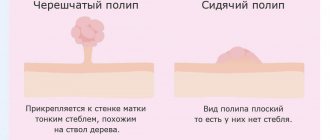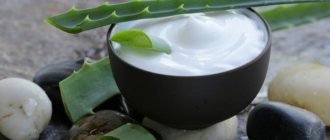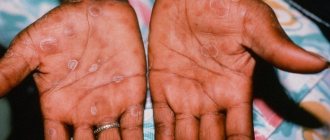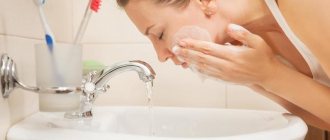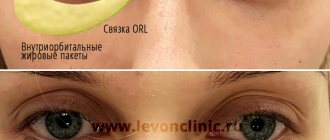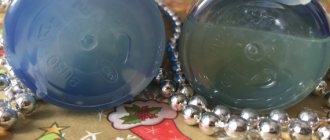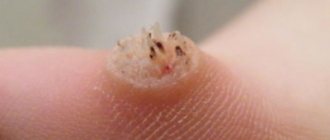Weeping dermatitis is one of the types of skin diseases that develops under the influence of negative external or internal factors on the epidermal tissue. In most cases, weeping of the skin occurs after pathogens of streptococcal infection enter the dermis. Weeping dermatitis is distinguished by the fact that the surface of the affected skin is in a constant state of inflammation, wet to the touch, and over time becomes covered with ulcerative formations with the release of purulent contents. Based on its location, this disease can occur on any part of the body, but most often occurs in folds and places where the skin is poorly ventilated.
What is weeping
Weeping is a weeping area on the skin that occurs as a result of an abnormal process, which is expressed in the exudation (secretion) of serous, bloody or purulent fluid (exudate) through small erosions (damages) of the epidermis (the upper layer of the skin).
Weeping is not a disease, it is a sign of a pathological process occurring in a separate area of the skin or a symptom of internal disorders and dermatological diseases.
Serous exudate looks like a transparent whitish liquid containing proteins, leukocytes (white blood cells), breakdown products, and toxins.
The leading factors in the manifestation of weeping erosions due to exudation are considered to be:
- increased permeability of blood vessels (capillaries, venules - small veins) as a result of inflammation or aggression of allergens;
- as well as an increase in pressure in the vessels of affected tissues due to hyperemia (overflow of blood).
Weeping behind the ears of a child (photo)
Treatment methods for weeping dermatitis
Due to the fact that weeping dermatoses occur due to systemic imbalance of the body, treatment should be comprehensive:
- drug therapy;
- change in eating habits (change of diet);
- Some patients also use the experience of traditional medicine.
Whether to use folk remedies or not is up to everyone to decide for themselves. But it would still be wiser to consult a doctor.
Changing your diet
Often there is a need to radically change your menu and give up foods that can trigger allergies:
honey;- pineapples;
- citrus;
- chocolate;
- eggs;
- tomatoes;
- kiwi;
- strawberry;
- confectionery;
- fatty, fried and smoked foods.
Allowed to eat:
- vegetables (broths, stews);
- cereals (buckwheat, millet, oatmeal);
- lean meats and fish (boiled or steamed);
- fermented milk products: kefir, fermented baked milk, cottage cheese;
- plenty of liquid (ideally clean water).
Eating plant foods will be more beneficial (especially during the acute period of the disease). The only fats allowed are olive and flaxseed oil. And there should be a sufficient amount of greens in the diet.
How to identify it in yourself
It is quite easy to identify your own weeping. In the area of skin damage, against a background of inflammation, swelling, and redness, multiple pinpoint lesions (erosions) covered with moisture are visible. The skin looks wet and shiny.
This phenomenon is observed in the following conditions:
- inflammation (viral, bacterial, fungal nature);
- opening of vesicles (vesicles, blisters);
- intense scratching;
- superficial and deep wounds, ulcers;
- burns, frostbite.
What disorders may this symptom indicate?
In the vast majority of cases, weeping as a symptom is characteristic of the following diseases:
- atopic, weeping dermatitis, all types of itchy dermatitis;
- exudative psoriasis;
- versicolor - eczema;
- blistering dermatoses, including pemphigus, bullous pemphigoid, epidermolysis;
- contagious (wetting) impetigo;
- bedsores and diaper rash;
- trophic ulcers;
- serous or purulent omphalitis (“weeping navel”) in infants - a pathology with characteristic exudate from the umbilical wound and slow healing;
- weeping hemorrhoids (III – IV stage of the disease);
- burns and frostbite;
- chicken pox;
- purulent skin lesions, including: diffuse and ulcerative streptoderma (ecthyma), intertriginous streptoderma (streptococcal intertrigo).
How to deal with this symptom
Since weeping is a symptom phenomenon, complete relief from it is possible by curing the causative disease in which this symptom occurs. Thus, with weeping eczema, therapy aimed at eliminating neurotic disorders and neuroendocrine disorders will also affect the external signs of the disease, including weeping.
Local preparations that are used externally can significantly reduce the severity of this unpleasant manifestation, reduce tissue inflammation and the intensity of exudate, dry the wound area, relieve itching and burning.
Important! The use of any drug requires mandatory review of the instructions and agreement with the doctor, since the choice of a specific gel, emulsion, solution depends on the type of disease. A medicine recommended for weeping caused by one pathology may be prohibited for another disease.
General recommendations
Weeping or vesicles (bubbles) with exudate usually indicate the acute stage of the disease, when the skin is easily infected, primarily by staphylococci and streptococcal flora.
Many experts insist that at the stage of fluid secretion, one should not use anti-inflammatory fatty ointments, which can worsen the condition of the affected areas, but only creams and emulsions that do not interfere with the evaporation of moisture.
In case of severe exudation against the background of various skin lesions, zinc-based drying and astringent agents, creams and emulsions, lotions and wet-dry dressings with medicinal solutions, non-steroidal and serious hormonal ointments with anti-exudative action are used.
This video will tell you how to treat and how to treat weeping with atopic dermatitis:
Lotions
One of the simple and effective ways to soften weeping acute inflammatory processes (dermatitis, eczema) is cold lotions and wet-drying with medicinal solutions. The mechanism of action is based on the evaporation of water, cooling the skin, astringent and drying effect. When the skin cools, the blood vessels in the affected weeping area constrict, which leads to a decrease in the severity of weeping and inflammation.
For lotions use:
- Burov's liquid (1 teaspoon per 200 ml of water);
- boric acid 2%;
- silver nitrate 0.025%;
- tannin solution 4%;
- Dimexide solution (including erysipelas, eczema, deep burns) 25 – 90%;
- Resorcinol 1%.
Experts often advise that in case of “wet” skin changes, make lotions not with alcohol, so as not to dry out or burn the damaged skin, but with water or saline solution. The most gentle effects have:
- furatsilin (1 tablet per 200 ml of water);
- solution of potassium permanganate (potassium permanganate 0.05%) pale pink;
- decoctions with oak bark, black currant leaves, tricolor violet, chamomile, birch buds, sage, bay leaf, coltsfoot herb;
- weak brew of black tea;
- mumiyo solution (3 grams per glass of water).
It is advisable to keep the lotion solution in the refrigerator. A wide bandage folded in several layers is moistened in it, wrung out very well, and applied to the affected area. As soon as the lotion begins to warm up (after 5 minutes), the procedure is repeated with a cool solution. Duration – up to one and a half hours, twice a day.
For the bandage, use up to 12 layers of gauze, put a little absorbent cotton wool (natural) on top, secure it loosely with a bandage and change it after 1 to 3 hours as it dries. Bandages act similar to lotions, but are less effective.
Important! Do not allow the lotions to become warm, as this may increase exudation and inflammation.
Separately, it should be said about weeping hemorrhoids. To reduce weeping in the anal area, lotions and baths with knotweed, chamomile, burdock root, oak bark, eucalyptus, and rowan are used. Add mumiyo, garlic juice, onion peel decoction, propolis, birch tar and sea buckthorn oil.
Wetting of the skin on the back of the hands
Drugs for inflammatory processes with exudation
In the combined treatment of weeping areas, in addition to lotions, external agents of varying degrees of effectiveness are used.
External medications that help with weeping:
| A drug | Pathologies |
| Desitin cream |
Especially recommended for young patients due to the minimum of side effects |
| Tsindol, chatterbox | |
| Zinc paste | |
| "Ambulance". Natural powder | Drying agent for various injuries with weeping. Anti-inflammatory, disinfectant, healing effect |
| Baneocin powder |
|
| Powder and powder Xeroform |
Low toxicity, non-irritating, minimal adverse reactions |
| Fukortsin | Use with caution to avoid drying and burning the skin. Possible severe burning sensation. |
| Methylene blue | |
| Brilliant green (“zelenka”) | |
| Elidel (stronger analogue - Protopic) | Atopic dermatitis, weeping eczema (except microbial) |
| Elokom cream, lotion; Momat cream |
Use caution in children and large affected areas |
| Hormonal agents | |
| Sinaflan liniment (highly active glucocorticosteroid) | “Wet” dermatitis, eczema, diaper rash and bedsores with exudate, exudative forms of erythema, psoriasis |
| Advantan, emulsion (highly active) | Used for acute and chronic dermatitis, eczema accompanied by exudation. Suppresses inflammatory reactions associated with increased exudation, leading to a reduction in weeping, itching, pain, and irritation |
| Afloderm cream (moderate activity) | In particularly sensitive areas (face, chest, genitals). Allowed for children from 6 months, nursing and pregnant women |
| Flucinar gel (highly active) | For “wet” eczema and dermatitis with weeping |
| Lokoid Crelo, emulsion (low-active), Lokoid cream | Weeping areas in various skin pathologies |
Active non-hormonal agents for severe erosion
For weeping lesions on the skin, it should be borne in mind that symptom treatment is carried out in stages, taking into account the stages of the pathological process in these areas. First, dry it, then protect it.
Strong non-steroidal drugs:
- Stellanin PEG ointment.
Stellanin PEG with antimicrobial, regenerating and anti-inflammatory effects, unlike Stellanin ointment, is used specifically for weeping skin pathologies associated with infection:- trophic weeping ulcers, bedsores;
- weeping areas due to burns;
- severe scratching after insect bites.
- Gel Solcoseryl.
It is the medicinal form of Solcoseryl in the form of a fat-free gel that reduces and prevents exudation and wetting of wound areas, and stimulates the formation of collagen fibers.
If the exudate ceases to be released and the process of “drying” occurs, you can begin to use ointments Solcoseryl, Stellanin, Actovegin, which create a protective film.
Causes
The skin can react negatively to a variety of internal and external factors. The occurrence of weeping dermatitis is most often associated with:
- Various disorders in the digestive tract. With such health problems, food may not be broken down normally in the stomach and intestines, and may not be absorbed. The skin can react very sharply to these processes.
- Functional disorders in the activity of the liver or kidneys.
- Food allergies.
- Chronic stressful conditions, constant nervous tension, depressive disorders.
- Contact with various substances that are highly aggressive and/or allergenic. This applies to plants, chemicals, various cosmetics, animals and their waste products. The more often and more intensely a person comes into contact with possible allergens, the higher the risk of developing dermatitis.
- Hereditary predisposition (this especially applies to cases of atopic dermatitis).
- Bacterial skin infections.
- Individual reaction to the use of certain medications.
- Disturbances in the functioning of the endocrine system (including diabetes mellitus).
- Severely weakened immune system, including due to bad habits and various health problems.
Only a doctor can accurately determine the cause of weeping dermatitis. Correct identification of the provoking factor and its elimination is an important condition for successful therapy.
In a baby
Weeping skin in an infant may be explained by:
- The development of so-called diaper dermatitis. This disease usually occurs in isolation - under a diaper, due to insufficient proper care of children's skin (use of a tight diaper, irregular diaper changes, general warming, etc.).
- The debut of atopic dermatitis. This disease is of an allergic nature and occurs due to a hereditary predisposition.
The appearance of areas of weeping, inflamed skin on the baby’s body is a reason to seek medical help as soon as possible. Parents should call a pediatrician at home or make an appointment with an experienced physician themselves.
